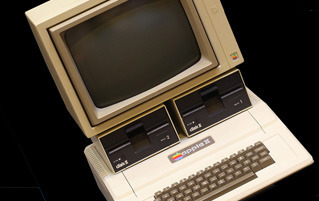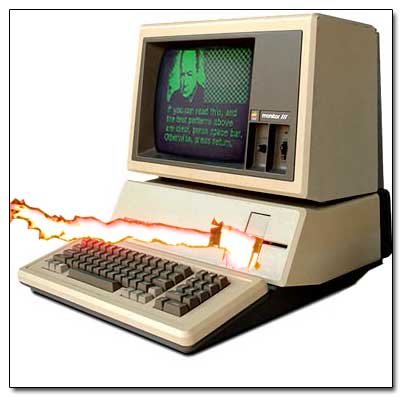The 5 Most Ridiculously Awful Computers Ever Made

Bitch all you want about the computer you're using now, about how it's short on RAM and infected with spyware and Windows Vista, but that machine stands on the shoulders of giants. Retarded giants.
What we're trying to say is that in order to get you the machine that functions at the level it does, the PC industry went through many, many horrible designs and ill-conceived products. So you can bitch about the cheap Gateway laptop you've been using for five years, but at least it's not...
The 3com Audrey (2000)

A good sign that something unfortunate is afoot at your technology company is when someone proposes naming your new computer after a dead actress. Say Audrey Hepburn for instance. Also cause for concern is when they decide to market it as an Internet appliance instead of a computer, as Internet appliance sounds a bit like a dildo that checks your stocks for you.
Launched in 2000, the makers of the Audrey designed their tool specifically for the kitchen and to do far, far less than a normal PC would do, because trendy, on the go internet users of the new millennium had no time to walk back to the living room or bedroom, they needed to see what eBay had to offer while they frosted their toaster strudel.

"And after the frosting, we'll search Craigslist for some sexually creative serving suggestions!"
In an attempt to make the Audrey unique, which is marketing talk for "incompatible with anything and grossly inconvenient to use" the Audrey came in such technologically exciting shades as "linen" and "sunshine." It had a whopping eight-inch screen--probably enough to read the first half of this sentence--and subscribers got to have access to "channels" specifically designed and optimized for the Tiny Tim-sized screen.
As a fun bonus, channels could be changed by turning a knob, kind of the same way you do on your TV, if you haven't bought a TV since the 1970s.
Look, you can see what was going on here. Somebody at 3Com said, "Let's design a computer for 'the kitchen'" using air quotes to mark the last two words, with everyone in the room knowing that it meant "for women."
"So what do computer users in 'the kitchen' want? A computer seemingly designed for a toddler, that's what! Without all those scary buttons and programs to boggle their simple, woman minds!"

Dismayed that the world was not in fact populated by housewives from 1955 sitcoms, the $500 device was yanked from shelves less than a year after it debuted.
The Coleco Adam (1983)

We understand that personal computers were still pretty primitive in the 80s. Basically, a machine sold back then had to satisfy two requirements: entering the wrong command wouldn't cause the Reds to launch nukes at Nebraska, and the computer wouldn't spontaneously erase whatever program you were trying to run. The Coleco Adam only satisfied one of those.
As you probably guessed, this was made by the Coleco company, the creators of Colecovision. That system was destined to drown in the shadow of the Atari 2600, and so this machine was attempt to horn in on the home computer market. And sure, there were minor issues, like the fact that the power supply ran through the printer (that is, if the printer broke, your computer was a paperweight).

But inexplicably more ridiculous than that, however, was that the Adam, like any good supervillain, released a a surge of magnetism when turned on. And its software was stored on cassette tapes. If you don't see the problem with this, you're too young to know what magnets did to cassettes (hint: It's the same thing that a big wave does to a sand castle).
So thousands of customers found out that after starting the machine a few times, tapes kept nearby would wind up blank. For added kicks, the instruction manual that was circulated with the Adam told users to have the software tapes inside the computer before startup, ensuring they would always be right there in the line of fire.

Unsurprisingly, despite their efforts to fix the problem (which included putting a sticker on new computers warning that it will fry your shit), customers were less than enthused and, within two years, the Adam was gone from the marketplace.
The Timex Sinclair 1000 (1982)

KAPOW! Look at that shit up there! That computer is so smart it's shooting out holy beams of computer light!
And what's that? It's only $99.95? Holy crap, why were there any other computer companies still in business after the Timex Sinclair 1000 hit the market? Sure, that's $99.95 in 1982 dollars, but that's also a 1982 computer, back when super computers were still the size of office buildings and had to be cooled with blocks of ice.

Needless to say, people couldn't resist. Ads had to be taken out in newspapers all over the country just to let people know where they could fine one. It was like the Nintendo Wii that first Christmas it was out. And really, the only difference between the Sinclair 1000 and the competing systems that could cost up to 100 times as much, was that they actually functioned.
With its totally hardcore 2KB of RAM and ability to display 32 columns and 24 lines in sleek, sexy, early 80s black and white, the TS1000 did nothing. We're not exaggerating; you could fill those lines and columns with some text, then presumably erase it and type more. Notice that you could do much the same with an Etch-A-Sketch. It had no ability to save your work (though you could hook a tape recorder up to it if you had one).
If you wanted your computer to, you know, actually run programs and stuff, you needed to buy a $200 memory expansion that gave you the 16KB of memory that programs at the time required. Yes, the expansion you needed to use the machine cost twice as much as the machine itself. Oh, and they couldn't make enough of the expansions for everybody who needed them. So the rest were stuck with a $100 notepad.

Did we mention the keyboard? The keyboard had problems. Specifically, the fact that it didn't have keys. It used a membrane style keypad so that you couldn't actually feel the keys under your fingers as you typed.
Despite selling a shitload of these, Timex bailed out on the home computer market just two years later, presumably chased away by a crowd carrying torches and pitchforks.
PocketMail (2000)

Imagine being able to check or send e-mail anytime, anywhere. If you just imagined you were back in the year 2000 with your PDA, shut up. We're talking about the miracle of PocketMail, which was like a PDA except all it did was send and receive e-mail. Hell, what's wrong with that? For 2000, that's still freaking state of the art!
Wait, did we mention that you had to hold it up to a land line telephone to work?

Keep in mind, cell phones had the ability to send texts as early as the mid 90s and, you know, there was always actual computers in your home, at the library, wherever. Plus if you were stuck out somewhere without a cell phone or a computer handy, you still needed to get to a payphone to use your PocketMail, at which point you could always just use the phone and call whoever you want to talk to, since you have to have the thing right there anyway.
It also pulled off the miraculous design feat of being too big to fit in your pocket, yet too small to be comfortable to type on like a laptop.
While a few people out there still sing the praises of PocketMail--the same people who used to do soil sampling out in the remote sections of the Mojave and wanted the convenience of being able to forward hilarious LOLcats at the same time--the rest of us realized that every single other portable device in the world offered the same feature plus numerous additions, none of which required you to hold it up to a phone. It was a solution to a problem that only like six people in the world had.

The company that manufactured the thing in Australia even crapped out on it and decided the next obvious business venture was uranium mining. Sure, we totally trust these guys with shipping tons of uranium around the world. No way that operation is going to result in a mountain exploding.
The Apple III (1980)

Now just settle down, Apple lovers. We're all friends here. That's right, just lay the gun on the table. See, not so long ago Apple wasn't the kickass manufacturer of iPods and paper-thin laptops it is now. It was more of a shithole joke of a company that couldn't sell a whore to Charlie Sheen even if she came with QuickTime already installed. Lucky for them they persevered, despite a history of machines like the Apple III.
The Apple III, while aesthetically as retarded as any computer from the 80s, had the problem of trying to cram a whole lot of computer into a relatively small space. Which is totally in the spirit of cutting-edge Apple, only this is 1980 we're talking about here. As we mentioned, this was a time when any computer powerful enough to display a photograph required a crew of 30 men to stand in a circle and blow on it.
Nowadays, computers have internal cooling fans and heat sinks all over them to take care of this. Back in the 80s the Apple crew figured that shit was for pussies, so the aluminum case was meant to act as a heat sink; devoid of a fan or even vents. If you've ever tried to escape the summer heat by climbing into an unventilated aluminum box you'll understand why this was a shittastic idea.

The result was that chips would actually pop free from their sockets as the metal heated and expanded. Machine owners experiencing problems were given the most awesome set of troubleshooting instructions in the history of computing: Lift the dead machine a few inches of the ground and drop it. Turn it on and see if it works.
The hope was that the impact would seat the chips again. That's right. When Apple Computer, Inc., designer of some of the most elegant machines in the history of anything, got calls from thousands of customers that their new computer had died, their first question was, "Have you tried dropping it?"

There were other rumors about the Apple III, including that it could fucking melt floppy disks in the drive (though it seems like it would have fried wiring inside by the time it got up to that temperature, can you dismiss anything at this point?). We guess it's sort of inspirational that Apple recovered from that fiasco and now makes products that probably 80 percent of the people reading this have on their person.
Speaking of which, all you kids who were born too late to have bought any of the shit in this article? You got off easy.
Ian is currently using his Commodore 64 to post ASCII porn over at ScenicAnemia.com.
Have an idea for an article? Think you're funny? Just go here and sign up. No experience necessary.
For more technological bombs, check out The 6 Most Retarded Gaming Consoles Ever Released. Or find out how we know directors and writers never went to Computer 101, in 5 Things Hollywood Thinks Computers Can Do.
Or swing by our Top Picks to see Wong trying to convince the office that his "PocketMail is totally awesome, you guys."
Don't forget to follow us on Twitter to get previews of upcoming articles and trick your friends into thinking you're psychic.